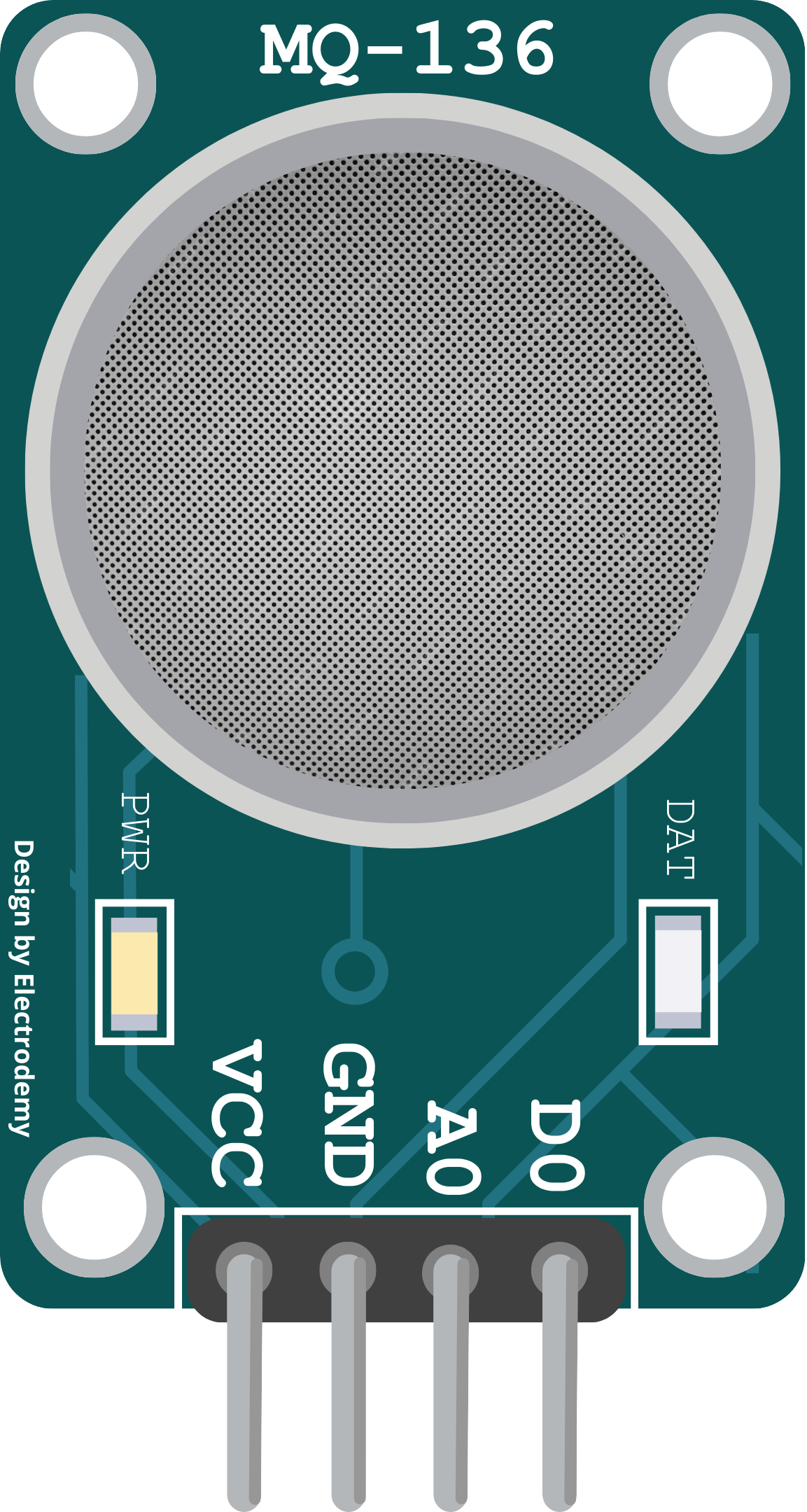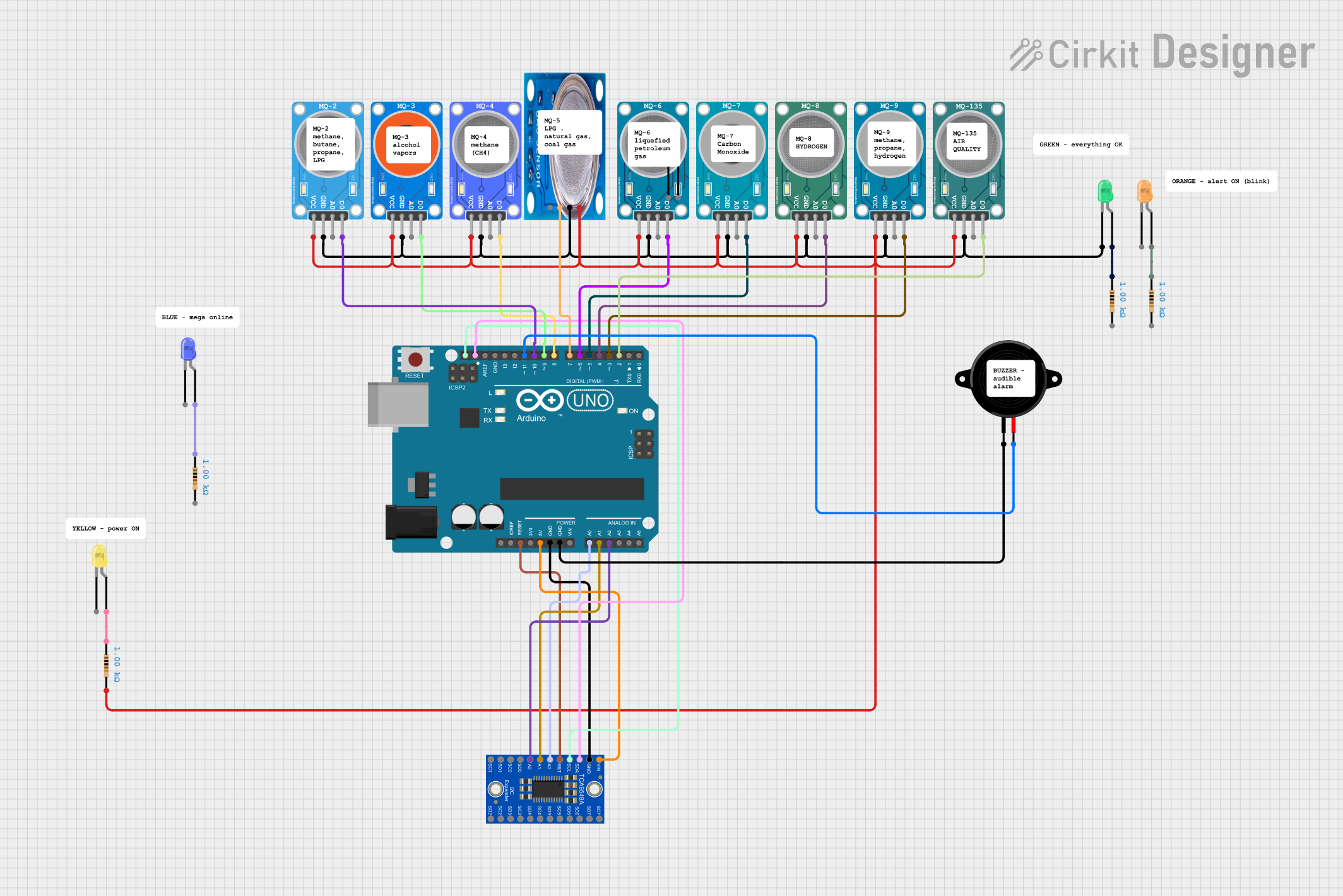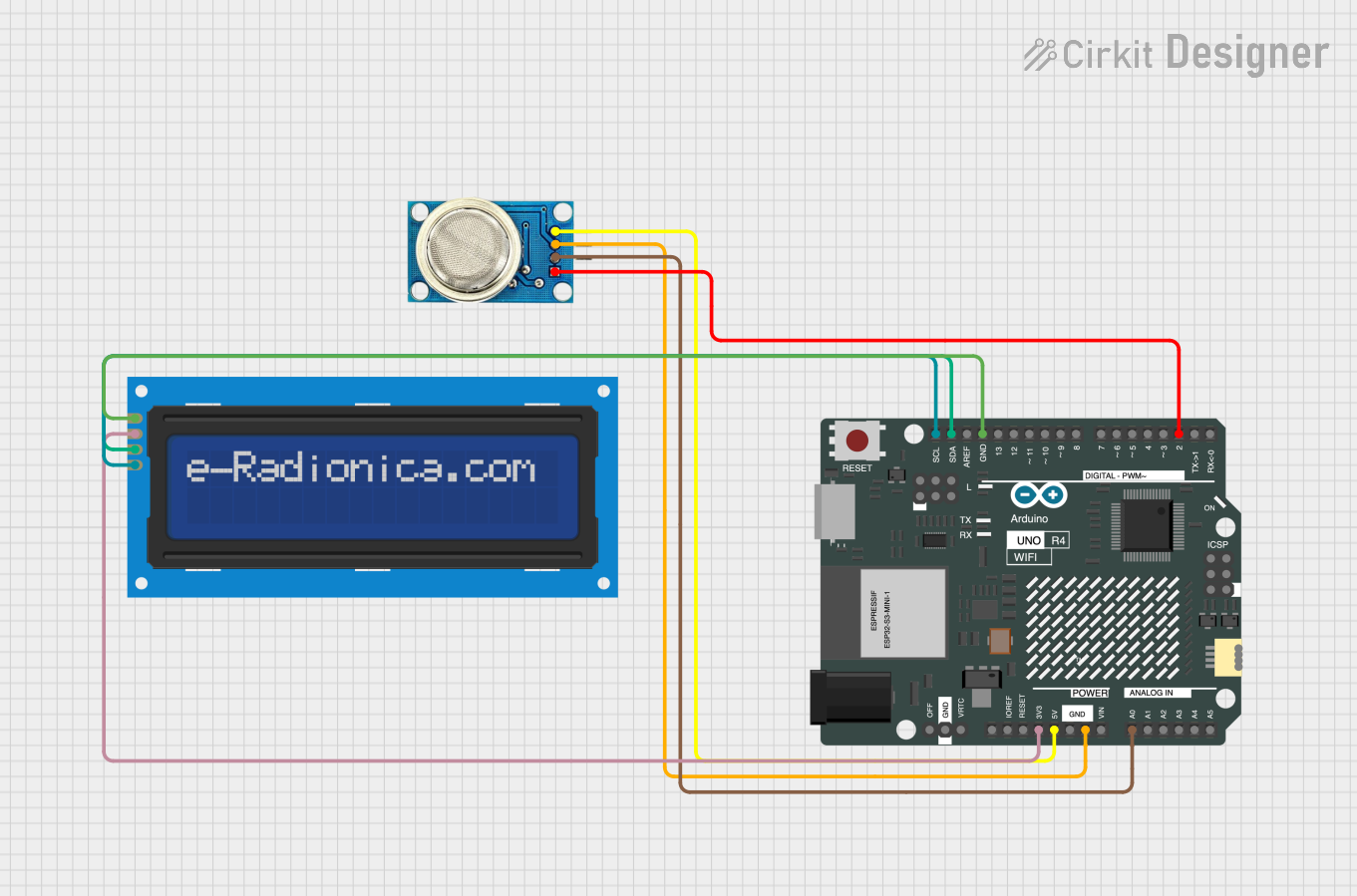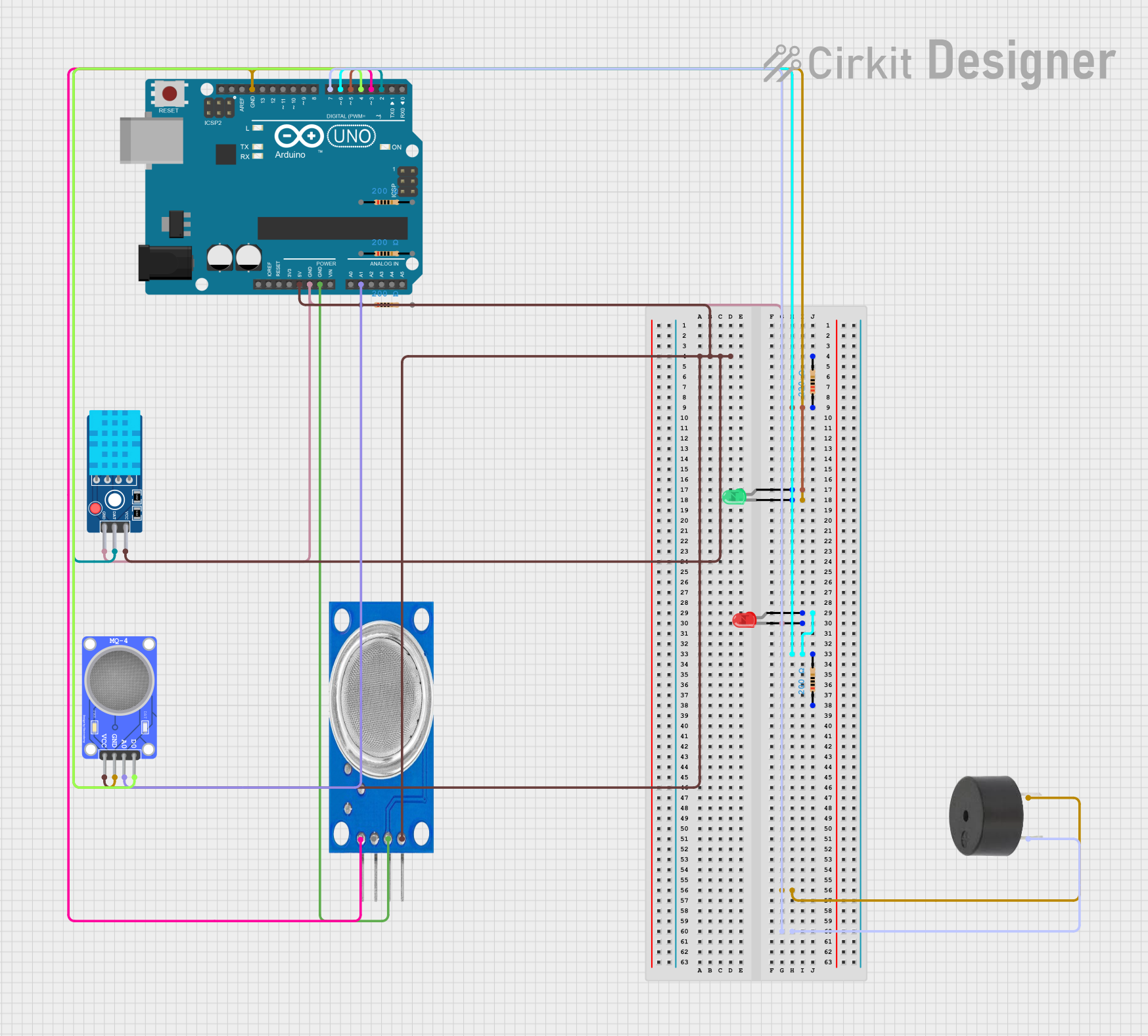
Cirkit Designer
Your all-in-one circuit design IDE
Home /
Component Documentation
How to Use MQ-136 SENSOR HYDROGEN SULFIDE GAS: Examples, Pinouts, and Specs

 Design with MQ-136 SENSOR HYDROGEN SULFIDE GAS in Cirkit Designer
Design with MQ-136 SENSOR HYDROGEN SULFIDE GAS in Cirkit DesignerIntroduction
The MQ-136 Hydrogen Sulfide (H2S) Gas Sensor is an electronic device used to measure the concentration of hydrogen sulfide gas in the air. This sensor is widely used in industrial applications, environmental monitoring, and safety systems where the presence of H2S, a toxic and corrosive gas, needs to be detected and measured.
Explore Projects Built with MQ-136 SENSOR HYDROGEN SULFIDE GAS
ESP32-Powered Environmental Monitoring System with SCD30, MQ-136, and Methane Sensors

This circuit is designed for environmental monitoring, utilizing an ESP32 microcontroller to collect data from various sensors including an MQ-136 for H2S detection, an SCD30 for CO2 and humidity measurement, and an SJH-100A for methane detection. The collected data is processed and can be integrated with Home Assistant for real-time monitoring and analysis.
 Open Project in Cirkit Designer
Open Project in Cirkit DesignerMulti-Gas Detection System with Arduino and MQ Sensors

This circuit is designed to monitor various gases using a series of MQ gas sensors (MQ-2, MQ-3, MQ-4, MQ-5, MQ-6, MQ-7, MQ-8, MQ-9, and MQ-135), each providing digital outputs to an Arduino UNO microcontroller. The Arduino is also connected to a piezo speaker for audible alerts and multiple LEDs with resistors, likely for visual status indicators. An Adafruit TCA9548A I2C multiplexer is included, suggesting the potential for I2C sensor expansion or managing multiple I2C devices.
 Open Project in Cirkit Designer
Open Project in Cirkit DesignerHydrogen Gas Detection System with MQ-8 Sensor and Arduino UNO R4 WiFi

This circuit uses an Arduino UNO R4 WiFi to measure hydrogen gas levels with an MQ-8 Hydrogen Gas Sensor and display the results on a 16x2 I2C LCD screen. The MQ-8 sensor provides both analog and digital outputs to the Arduino, which processes the data and updates the LCD screen with the current gas levels.
 Open Project in Cirkit Designer
Open Project in Cirkit DesignerArduino UNO Based Gas Detection System with MQ Sensors and DHT11

This circuit is designed to monitor gas levels using MQ135 and MQ-4 gas sensors and to measure temperature and humidity with a DHT11 sensor. It uses an Arduino UNO to read sensor data and control a green LED, a red LED, and a buzzer for visual and audible alerts. The green LED and buzzer are activated when high gas levels are detected, while the red LED indicates low gas levels.
 Open Project in Cirkit Designer
Open Project in Cirkit DesignerExplore Projects Built with MQ-136 SENSOR HYDROGEN SULFIDE GAS

ESP32-Powered Environmental Monitoring System with SCD30, MQ-136, and Methane Sensors
This circuit is designed for environmental monitoring, utilizing an ESP32 microcontroller to collect data from various sensors including an MQ-136 for H2S detection, an SCD30 for CO2 and humidity measurement, and an SJH-100A for methane detection. The collected data is processed and can be integrated with Home Assistant for real-time monitoring and analysis.
 Open Project in Cirkit Designer
Open Project in Cirkit Designer
Multi-Gas Detection System with Arduino and MQ Sensors
This circuit is designed to monitor various gases using a series of MQ gas sensors (MQ-2, MQ-3, MQ-4, MQ-5, MQ-6, MQ-7, MQ-8, MQ-9, and MQ-135), each providing digital outputs to an Arduino UNO microcontroller. The Arduino is also connected to a piezo speaker for audible alerts and multiple LEDs with resistors, likely for visual status indicators. An Adafruit TCA9548A I2C multiplexer is included, suggesting the potential for I2C sensor expansion or managing multiple I2C devices.
 Open Project in Cirkit Designer
Open Project in Cirkit Designer
Hydrogen Gas Detection System with MQ-8 Sensor and Arduino UNO R4 WiFi
This circuit uses an Arduino UNO R4 WiFi to measure hydrogen gas levels with an MQ-8 Hydrogen Gas Sensor and display the results on a 16x2 I2C LCD screen. The MQ-8 sensor provides both analog and digital outputs to the Arduino, which processes the data and updates the LCD screen with the current gas levels.
 Open Project in Cirkit Designer
Open Project in Cirkit Designer
Arduino UNO Based Gas Detection System with MQ Sensors and DHT11
This circuit is designed to monitor gas levels using MQ135 and MQ-4 gas sensors and to measure temperature and humidity with a DHT11 sensor. It uses an Arduino UNO to read sensor data and control a green LED, a red LED, and a buzzer for visual and audible alerts. The green LED and buzzer are activated when high gas levels are detected, while the red LED indicates low gas levels.
 Open Project in Cirkit Designer
Open Project in Cirkit DesignerCommon Applications and Use Cases
- Industrial safety systems to detect gas leaks
- Environmental monitoring for air quality
- Laboratory research and analysis
- Mining operations where H2S is a byproduct
- Sewage treatment plants for odor control monitoring
Technical Specifications
Key Technical Details
- Sensor Type: Semiconductor
- Detection Gas: Hydrogen sulfide (H2S)
- Concentration Range: 1 ppm to 10 ppm (parts per million)
- Supply Voltage (Vcc): 5V ± 0.1V DC
- Output Voltage (VRL): 0.1 - 0.3V (in clean air)
- Preheat Duration: 20 minutes (minimum)
- Load Resistance: Adjustable via onboard potentiometer
- Operating Temperature: -20°C to 50°C
- Relative Humidity: 95% RH non-condensing
Pin Configuration and Descriptions
| Pin Number | Pin Name | Description |
|---|---|---|
| 1 | VCC | Power supply (5V DC) |
| 2 | GND | Ground connection |
| 3 | DOUT | Digital output (TTL logic level) |
| 4 | AOUT | Analog output (proportional to H2S) |
Usage Instructions
How to Use the Component in a Circuit
- Connect the VCC pin to a 5V power supply.
- Connect the GND pin to the ground of the power supply.
- The AOUT pin provides an analog voltage output that is proportional to the concentration of H2S gas. Connect this to an analog input on your microcontroller.
- The DOUT pin provides a digital signal when the concentration of H2S exceeds a certain threshold. This threshold can be adjusted using the onboard potentiometer.
Important Considerations and Best Practices
- Ensure the sensor is preheated for at least 20 minutes before taking accurate readings.
- Avoid exposure to high concentrations of organic solvents, silicon compounds, and sulfur which can poison the sensor.
- Calibrate the sensor periodically to maintain accuracy.
- Implement proper ventilation when using the sensor to prevent accumulation of gases.
Example Code for Arduino UNO
// MQ-136 Hydrogen Sulfide Gas Sensor Example Code
const int ANALOG_PIN = A0; // Analog input pin connected to AOUT on the sensor
const int DIGITAL_PIN = 2; // Digital input pin connected to DOUT on the sensor
void setup() {
Serial.begin(9600); // Initialize serial communication at 9600 baud rate
pinMode(DIGITAL_PIN, INPUT); // Set the digital pin as input
}
void loop() {
int sensorValue = analogRead(ANALOG_PIN); // Read the analog value from sensor
int digitalValue = digitalRead(DIGITAL_PIN); // Read the digital value from sensor
// Print the analog value to the serial monitor
Serial.print("Analog H2S Value: ");
Serial.println(sensorValue);
// Print the digital status to the serial monitor
Serial.print("Digital H2S Status: ");
Serial.println(digitalValue ? "HIGH" : "LOW");
delay(1000); // Wait for 1 second before the next loop
}
Troubleshooting and FAQs
Common Issues Users Might Face
- Inaccurate Readings: Ensure the sensor is properly preheated and calibrated.
- No Output Signal: Check the power supply and connections to the sensor.
- Sensor Poisoning: Avoid exposure to high concentrations of pollutants.
Solutions and Tips for Troubleshooting
- Preheat the Sensor: Always preheat the sensor for at least 20 minutes before use.
- Calibration: Perform regular calibration using known H2S concentrations.
- Check Connections: Ensure all connections are secure and free from corrosion.
FAQs
- Q: How often should the sensor be calibrated?
- A: Calibration frequency depends on usage, but typically every 6 months is recommended.
- Q: Can the sensor detect other gases?
- A: The MQ-136 is specific to hydrogen sulfide but may show cross-sensitivity to other gases.
- Q: What is the lifespan of the sensor?
- A: With proper use and maintenance, the sensor can last up to 2 years.
This documentation provides a comprehensive guide to using the MQ-136 Hydrogen Sulfide Gas Sensor. For further assistance, please refer to the manufacturer's datasheet or contact technical support.